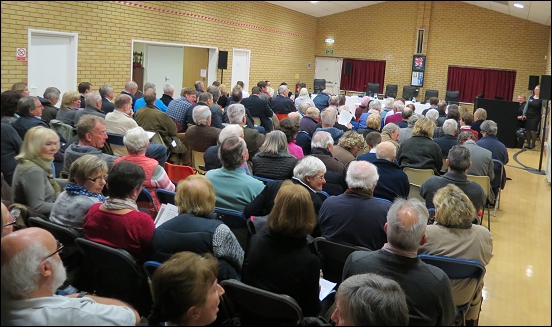Over 150 residents filled a village hall near Burnham-On-Sea last night (Tuesday) when the Planning Inspectorate held a public hearing on controversial plans by National Grid to build a 37-mile line of huge pylons across the Somerset Levels between Hinkley Point and Avonmouth.
National Grid’s plans came under attack by concerned residents and councillors during the hearing in Mark Village Hall.
Cllr Anne Fraser, from Sedgemoor District Council, told the meeting that the proposed 400,000 volt pylons represent “an intrusion” across the countryside and that the plans would have a “severe impact on the landscape.”
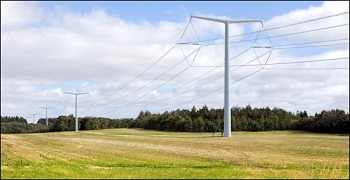 She said the proposed T-pylons would create an “alien, industrial landscape,” adding wryly that the huge proposed pylons would look “like a huge wind turbine with something like Pat Butcher’s ear-rings either side.”
She said the proposed T-pylons would create an “alien, industrial landscape,” adding wryly that the huge proposed pylons would look “like a huge wind turbine with something like Pat Butcher’s ear-rings either side.”
She said that a request for community impact mitigation is “entirely appropriate”, adding that the council is seeking £100,000 towards the River Parrett flood barrier scheme from National Grid. “That’s the top limit that a developer can be asked to contribute,” she said.
Richard Parker, representing three parish councils, told the meeting that the sub-sea power route option was preferred. However, he said the public had been “misled and uniformed” about the sub-sea option because National Grid had appeared to disregard this early on as ‘technically impossible’. He added that the proposed T-pylons are “untried and untested new technology” that poses a risk to the environment.
Katherine Fisher, a resident from Tarnock who lives under the planned pylons route, said her property is being “blighted” by the plans. She said National Grid has not listened to residents like her, adding: “they have asked for feedback but not taken any notice of the responses.” She said: “The impact on people and the environment would be massive – the view from Crook Peak is wonderful and I don’t understand why anyone would want to destroy it.”
David Shepherd, another resident living on the pylons route, said the structures would severely effect several thriving businesses near him which he claimed “have been overlooked and completely ignored.” He added that the pylons would effect “real people and real lives and are part of an undermining of the community.” He went on to say: “Why didn’t they try to spread the infrastructure further away from people. They have not given proper attention to the impact on people and our communities.”
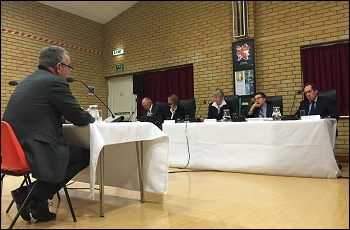 Doug Bamsey, Corporate Director at Sedgemoor District Council, right, told the meeting that the authority is “extremely concerned” by the low level of mitigation proposed by National Grid, which he says offers “little to counter balance the local impacts.”
Doug Bamsey, Corporate Director at Sedgemoor District Council, right, told the meeting that the authority is “extremely concerned” by the low level of mitigation proposed by National Grid, which he says offers “little to counter balance the local impacts.”
He went on to say that the council has also been “disappointed at the level of dialogue” provided by National Grid so far. He also said that Sedgemoor “does not object in principal to the scheme or route, but is interested in seeking the best mitigation possible.”
Eileen Corkish from Mark Parish Council told the meeting there had been “overwhelming opposition” to the scheme, with visual intrusion the key concern of residents. She said that the 15 pylons in her parish, each 31-metres wide, could not be hidden by trees and would be “alien to the landscape.” She went on to say that the plans “would have a major impact on the amenity value of the homes, would effect local tourism, and would change the local character.”
Nick Van Der Bijl, Mark Parish Council Chairman, told the meeting that the “overwhelming feeling in the parish is that the public is opposed to the pylons route and that the consensus is that the sub-sea route under the Bristol Channel or a redefined route is preferred.” He said that the process had “not been fair or reasonable, leading to cynicism and trust being a factor.”
He added: “For National Grid to say the pylons will blend into the landscape is frankly ludicrous,” and he questioned why the parish should be “penalised when proven alternatives exist.”
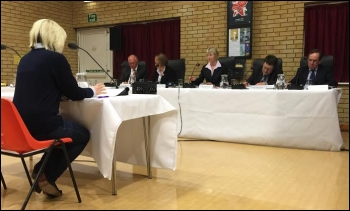 MP Tessa Munt told the hearing that the plans “should be rejected and re-thought seriously”, adding that they contravene national environmental government policies. She went on to say that the plans would severely hurt the local tourism economy. “This would be wanton vandalism – it would effect many incomes and would have a huge impact.”
MP Tessa Munt told the hearing that the plans “should be rejected and re-thought seriously”, adding that they contravene national environmental government policies. She went on to say that the plans would severely hurt the local tourism economy. “This would be wanton vandalism – it would effect many incomes and would have a huge impact.”
“We had a chance of this area being named the 17th World Heritage site and that’s now gone because of this scheme.”
Tessa added that “all pylons are unacceptable and no mitigation is acceptable,” adding that she is “completely unclear why electrical supplies remain a dinosaur service running overhead and not underground” when other options such as gas lines exist.
Paul Hipwell from the No Moor Pylons campaign group said that more work needs to be carried out on understanding the other options. “There are alternatives such as GIL – Gas Insulated Lines – whcih have been operating for 30 years with not a single failure.” He added: “It would be nice to see the public asked to give their views on the options with proper public consultation undertaken.”
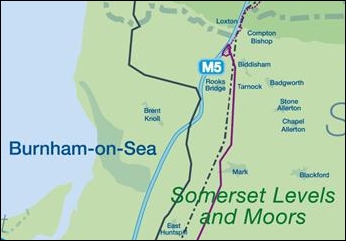 Cllr Alison Hamlin from East Huntspill aired her “great concern” about vehicle access during any build of the pylons, especially given that heavy lorries will want to use Factory Lane which she said would be “totally unacceptable” and would cause disruption to residents and businesses.
Cllr Alison Hamlin from East Huntspill aired her “great concern” about vehicle access during any build of the pylons, especially given that heavy lorries will want to use Factory Lane which she said would be “totally unacceptable” and would cause disruption to residents and businesses.
James Heappey, the Conservative’s General Election candidate, told the meeting that the because nearby wind farms had been turned down on visual amenity and tourism impact concerns, the pylons should be rejected too. He added: “While it’s impossible to put a cost on the impact of tourism, the pylons would spoil the ‘shop window’ for tourists entering Somerset – and that first impression would be damaged.” He added that the public felt there are “real suspicions that key decisions have already been taken” and that discussions with National Grid are like “pleading with the executioner.”
He added that National Grid’s energy strategy does not appear to fully take into consideration the future energy scenarios. “They see huge potential from energy creation in the Bristol Channel, but they have not reconciled the considerable number of connection requests or factored in a cost / benefit analysis.”
Bruce Penrose also raised health fears during the session, asking whether the effects of radiation from the power lines had been fully considered.
Nicholas Brown, on behalf of National Grid, ended the hearing by saying: “We are grateful for the contributions made and we will be responding to all the points made.”

